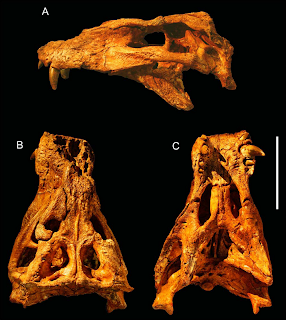Oops! Looks like I forgot to post my summaries of the remaining 8 crurotarsan-themed abstracts from this year's SVP. In my defense though, several of them were focused on making inferences about dinosaurs, so my subconscious mind may have let things slip. Better late than never.
The American alligator (
Alligator mississippiensis) seemed to be particularly popular this year, with a total of 8 abstracts dedicated to discussing aspects of the species' anatomy. Considering the alligator's availability for research and usefulness in studying extinct archosaurs, it's no surprise that these animals are such popular subjects for study.
Talks
"An intra-skeletal bone microanalysis of Alligator mississippiensis and its application to non-avian dinosaur osteohistology." Woodward, H.
- Osteohistologic analysis of Alligator mississippiensis. Results:
- each bone in an individual forms the same growth marks
- femur, humerus, and tibiae have the highest growth rates
- captive individuals show higher periodic growth than wild individuals = eco-phenotypic plasticity
- Used results to infer aspects of ornithiscian dinosaur growth. Results:
- basal ornithopods: rapid mineral deposition (tibia and femur) for only 2-3 growth cycles followed by slow deposition
- Maiasaurus shows high growth rates throughout ontogeny
"Development of the lung in Alligator mississippiensis (Archosauria: Crocodylomorpha) and the evolution of the Archosaurian respiratory system." Schachner, E., Metzger, R., and Farmer, C. G.
- description of the development of Alligator mississippiensis bronchi (and comparison with those of chickens)
- investigation of the effects on oxygen tension morphogenesis during development
- formation of bronchial chambers by branching morphogenesis with striking similarities in formation between alligators and birds
- data suggest that lung development in extant archosaurs is determined by similar molecular and genetic programs
"Microstructure of the femoral growth plate in the American alligator: effects of growth rate, locomotor activity and circulatory pattern." Owerkowicz, T., Yang, J., Blank, J., Eme, J., and Hicks, J.
- Are growth plates with a highly irregular border at the chondro-osseous junction a synapomorphy of dinosaur? Can growth plate thickness be used to determine skeletal growth rate?
- Alligator growth plates show highly irregular chondro-osseous borders
- Alligator growth plate height shows significant correlation with longitudinal growth rate
- data suggest that growth plates are sensitive to systemic arterial oxygen tension and that an irregular chondro-osseous junction is an ancestral character of archosaurs
- "propose a thicker growth plates appeared concurrently with the origin of in-series circulation, and may thus have set the stage for later acquisition of fast growth and endothermic metabolism in birds."
"Pelvic anatomy of Alligator mississippiensis and its significance for interpreting limb function in fossil archosaurs." Tsai, H., Holliday, C., and Ward, C.
- test the hypothesis that accurately predicting in-vivo range of motion in the hip of the American alligator cannot be done using hard tissue manipulation alone
- first description of American alligator acetabular anatomy
- data show that the bone-only model enabled for more movement than the soft-tissue model
- "this study provides new insight into soft tissue structures and their osteological correlations in the archosaur hip joint."
Posters
"Skeletochronology of the American alligator (Alligator mississippiensis): the utility of various elements for determining growth patterns and longevity." Garcia, B.
- histological analysis of every bone type in American alligators
- shows that, aside from long bones, elements like ribs and phalanges exhibit LAG deposition
- developed a "map" of the alligator skeleton showing the best areas for finding unobstructed LAG deposition, helping determine which bones are best for analysis and where information is best preserved along those bones
- information will allow researchers to make more informed sampling decisions given the destructive nature
"Variation in hindlimb muscle attachment sites in the American alligator (Alligator mississippiensis) and implications for paleobiological reconstructions." Taylor, E., Schachner, E., and Farmer, C.G.
- examined hindlimb musculature in 19 specimens of Alligator mississippiensis
- found high degrees of individual variation in most muscle attachments
- suggests a need for caution when using osteological correlates in myological reconstruction
"Trigeminal nerve morphology in Alligator mississippiensis: implications for inferring sensory potential in extinct crocodyliforms." George, C.
- cross-sectional study (histology, morphometrics, and 3D imaging) to identify patterns in neural and bony structures in Alligator mississippiensis and comparison with similarly-sized fossil crocodyliforms
- "data suggest that trigeminal nerve morphology can be accurately inferred among living crocodilians."
- extinct taxa:
- Leidysuchus (eusuchian) and Phabdognathus (dyrosaur) have trigeminal ganglia similar to alligators
- Hamadasuchus (peirosaur) had a much smaller ganglion (dome-pressure system not as well developed)
- "these findings suggest that neural osteological correlates of the trigeminal system are informative features useful for investigation of crocodyliform as well as archosaur somatosensory evolution."
"Structure and function of a protosuchian mandibular symphysis using anatomical insights from Alligator mississippiensis." Skiljan, R., Gant, C., and Holliday, C.
- comparison of the structure and function of the jaws (especially the mandibular symphysis) of protosuchians with Alligator mississippiensis
- data suggest a transitional form of the symphysis is present in protosuchians, compared to the derived condition in crocodyliforms




